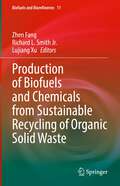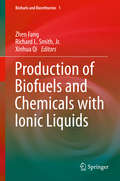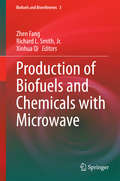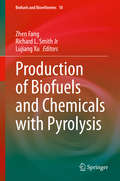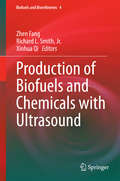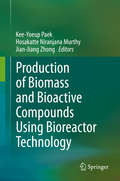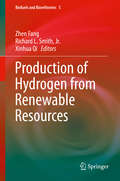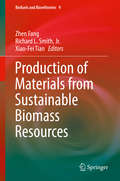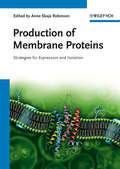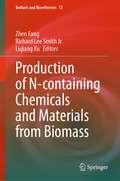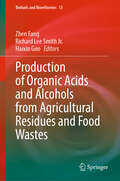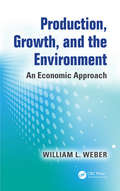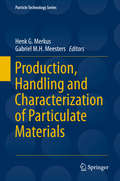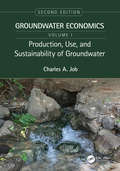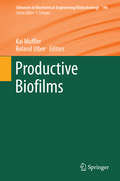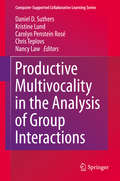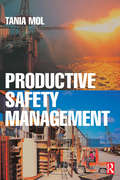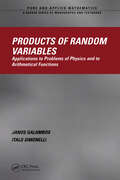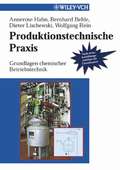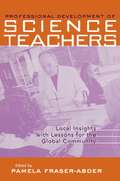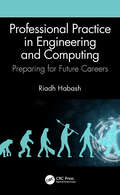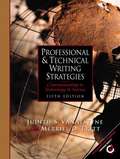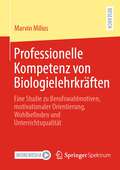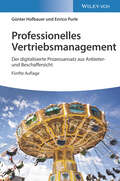- Table View
- List View
Production of Biofuels and Chemicals from Sustainable Recycling of Organic Solid Waste (Biofuels and Biorefineries #11)
by Richard L. Smith Zhen Fang Lujiang XuThis book covers sustainable recycling processes (e.g. physical, biological, chemical, and thermo-chemical) of multiple organic solid wastes, provides methods for material recycle of wastes into value-added products including fuels and commodity chemicals that are able to be directly applied to promote manufacturing processes. Aimed at improving the awareness of effective conversion protocols and for developing innovative biomass conversion processes, this text was conceived as a collection of studies on state-of-art techniques and know-how for production of biofuels and chemicals from sustainable recycling of organic solid wastes. Topics in the text are discussed in terms of addressing recent advances, assessing and highlighting promising new methods or new technological strategies and direct conversion of organic solid wastes to process feeds. Highly-recognized authorities, experts and professionals have contributed individual chapters in selected areas to cover the overall topic in a comprehensive manner.
Production of Biofuels and Chemicals with Ionic Liquids
by Richard L. Smith Zhen Fang Xinhua QiThe application of ionic liquids to biomass for producing biofuels and chemicals will be one of the hot research areas during the next decade due to the fascinating properties of these versatile group of solvents that allow them to dissolve lignocellulosic materials. The present text provides up-to-date fundamentals, state-of-the-art reviews, current assessments and prospects in this area, including aspects of pretreatment, fermentation, biomass dissolution, cellulose transformation, reaction kinetics and physical properties, as well as the subsequent production of biofuels and platform chemicals such as sugars, aldehydes and acids. Auxiliary methods such as catalysis, microwave and enzymatic techniques used in the transformations are covered. Both researchers and practitioners are certain to find a wealth of information in the individual chapters, which were written by experts in the field to provide an essential basis for assessing possible pretreatment and transformation routes of biomass using ionic liquids, and for developing new methods and chemical processes. Dr. Zhen Fang is Professor of Bioenergy, head of the Chinese Academy of Sciences' Biomass Group, Xishuangbanna Tropical Botanical Garden and is also an Adjunct Professor of Life Sciences, University of Science and Technology of China. Dr. Richard L Smith, Jr. is Professor of Chemical Engineering at the Graduate School of Environmental Studies, Research Center of Supercritical Fluid Technology, Tohoku University, Japan. Dr. Xinhua Qi is Professor of Environmental Science at Nankai University, China.
Production of Biofuels and Chemicals with Microwave
by Richard L. Smith Jr. Zhen Fang Xinhua QiConversion of biomass into chemicals and biofuels is an active research and development area as trends move to replace traditional fossil fuels with renewable resources. By integrating processing methods with microwave and ultrasound irradiation into biorefineries, the time-scale of many operations can be greatly reduced while the efficiency of the reactions can be remarkably increased so that process intensification can be achieved. "Production of Biofuels and Chemicals with Microwave" and "Production of Biofuels and Chemicals with Ultrasound" are two independent volumes in the Biofuels and Biorefineries series that take different, but complementary approaches for the pretreatment and chemical transformation of biomass into chemicals and biofuels. The volume "Microwave" provides current research advances and prospects in theoretical and practical aspects of microwave irradiation including properties, effects and temperature monitoring, design of chemical reactors, synergistic effects on combining microwave, ultrasound, hydrodynamic cavitation and high-shear mixing into processes, chemical and catalytic conversion of lignin into chemicals, pyrolysis and gasification, syngas production from wastes, platform chemicals, algal biodiesel, cellulose-based nanocomposites, lignocellulosic biomass pretreatment, green chemistry metrics and energy consumption and techno-economic analysis for a catalytic pyrolysis facility that processes pellets into aromatics. Each of the 12 chapters has been peer-reviewed and edited to improve both the quality of the text and the scope and coverage of the topics. Both volumes "Microwave" and "Ultrasound" are references designed for students, researchers, academicians and industrialists in the fields of chemistry and chemical engineering and include introductory chapters to highlight present concepts of the fundamental technologies and their application. Dr. Zhen Fang is Professor in Bioenergy, Leader and founder of biomass group, Chinese Academy of Sciences, Xishuangbanna Tropical Botanical Garden and is also adjunct Professor of Life Sciences, University of Science and Technology of China. Dr. Richard L Smith, Jr. is Professor of Chemical Engineering, Graduate School of Environmental Studies, Research Center of Supercritical Fluid Technology, Tohoku University, Japan. Dr. Xinhua Qi is Professor of Environmental Science, Nankai University, China.
Production of Biofuels and Chemicals with Pyrolysis (Biofuels and Biorefineries #10)
by Richard L. Smith Zhen Fang Lujiang XuThis book presents a collection of studies on state-of-art techniques for converting biomass to chemical products by means of pyrolysis, which are widely applicable to the valorization of biomass. In addition to discussing the fundamentals and mechanisms for producing bio-oils, chemicals, gases and biochar using pyrolysis, it outlines key reaction parameters and reactor configurations for various types of biomass. Written by leading experts and providing a broad range of perspectives on cutting-edge applications, the book is a comprehensive reference guide for academic researchers and industrial engineers in the fields of natural renewable materials, biorefinery of lignocellulose, biofuels, and environmental engineering, and a valuable resource for university students in the fields of chemical engineering, material science and environmental engineering.
Production of Biofuels and Chemicals with Ultrasound
by Richard L. Smith Zhen Fang Xinhua QiConversion of biomass into chemicals and biofuels is an active research and development area as trends move to replace traditional fossil fuels with renewable resources. By integrating processing methods with ultrasound and microwave irradiation into biorefineries, the time-scale of many operations can be greatly reduced while the efficiency of the reactions can be remarkably increased so that process intensification can be achieved. "Production of Biofuels and Chemicals with Ultrasound" and "Production of Biofuels and Chemicals with Microwave" are two independent volumes in the Biofuels and Biorefineries series that take different, but complementary approaches for the pretreatment and chemical transformation of biomass into chemicals and biofuels. The volume "Ultrasound" provides current research advances and prospects in mechanistic principles of acoustic cavitation in sonochemistry, physical and chemical mechanisms in biofuel synthesis, reactor design for transesterification and esterification reactions, lipid extraction from algal biomass, microalgae extraction, biodiesel and bioethanol synthesis, practical technologies and systems, pretreatment of biomass waste sources including lignocellulosic materials, manures and sludges for biogas production, vibration-assisted pelleting, combined chemical-mechanical methods, valorization of starch-based wastes and techno-economic methodology. Each of the 12 chapters has been peer-reviewed and edited to improve both the quality of the text and the scope and coverage of the topics. Both volumes "Ultrasound" and "Microwave" are references designed for students, researchers, academicians and industrialists in the fields of chemistry and chemical engineering and include introductory chapters to highlight present concepts of the fundamental technologies and their application. Dr. Zhen Fang is Professor in Bioenergy, Leader and founder of biomass group, Chinese Academy of Sciences, Xishuangbanna Tropical Botanical Garden and is also adjunct Professor of Life Sciences, University of Science and Technology of China. Dr. Richard L Smith, Jr. is Professor of Chemical Engineering, Graduate School of Environmental Studies, Research Center of Supercritical Fluid Technology, Tohoku University, Japan. Dr. Xinhua Qi is Professor of Environmental Science, Nankai University, China.
Production of Biomass and Bioactive Compounds Using Bioreactor Technology
by Jian-Jiang Zhong Kee-Yoeup Paek Hosakatte Niranjana MurthyThe bioactive compounds of plants have world-wide applications in pharmaceutical, nutraceutical and food industry with a huge market. In this book, a group of active researchers have addressed on the most recent advances in plant cell and organ cultures for the production of biomass and bioactive compounds using bioreactors. Tremendous efforts have been made to commercialize the production of plant metabolites by employing plant cell and organ cultures in bioreactors. This book emphasizes on the fundamental topics like designing of bioreactors for plant cell and organ cultures, various types of bioreactors including stirred tank, airlift, photo-bioreactor, disposable bioreactor used for plant cell and organ cultures and the advantages and disadvantages of bioreactor cultures. Various strategies for biomass production and metabolite accumulation have been discussed in different plant systems including Korean/Chinese ginseng, Siberian ginseng, Indian ginseng, Echinacea, St. John's wort, Noni, Chinese licorice, Caterpillar fungus and microalgae. Researches on the industrial application of plant cells and organs with future prospects as well as the biosafety of biomass produced in bioreactors are also described. The topics covered in this book, such as plant cell and organ cultures, hairy roots, bioreactors, bioprocess techniques, will be a valuable reference for plant biotechnologists, plant biologists, pharmacologists, pharmacists, food technologists, nutritionists, research investigators of healthcare industry, academia, faculty and students of biology and biomedical sciences. The multiple examples of large-scale applications of cell and organ cultures will be useful and significant to industrial transformation and real commercialization.
Production of Hydrogen from Renewable Resources
by Richard L. Smith Zhen Fang Xinhua QiThis book provides state-of-the-art reviews, current research and prospects of producing hydrogen using bio, thermal and electrochemical methods and covers hydrogen separation, storage and applications. Hydrogen produced from biomass offers a clean and renewable energy source and a promising energy carrier that will supplement or replace fossil fuels in the future. The book is intended as a reference work for researchers, academics and industrialists working in the chemical and biological sciences, engineering, renewable resources and sustainability. Readers will find a wealth of information in the text that is both useful for the practical development of hydrogen systems and essential for assessing hydrogen production by bioelectrochemical, electrochemical, fermentation, gasification, pyrolysis and solar means, applied to many forms of biomass. Dr. Zhen Fang is Professor in Bioenergy, Leader and founder of biomass group, Chinese Academy of Sciences, Xishuangbanna Tropical Botanical Garden and is also adjunct Professor of Life Sciences, University of Science and Technology of China. Dr. Richard L Smith, Jr. is Professor of Chemical Engineering, Graduate School of Environmental Studies, Research Center of Supercritical Fluid Technology, Tohoku University, Japan. Dr. Xinhua Qi is Professor of Environmental Science, Nankai University, China.
Production of Materials from Sustainable Biomass Resources (Biofuels and Biorefineries #9)
by Zhen Fang Richard L. Smith Jr Xiao-Fei TianThis book presents a collection of studies on state-of-art techniques developed specifically for lignocellulose component derivation, and for the production of functional materials, composite polymers, carbonaceous biocatalysts, and pellets from lignocellulosic biomass, with an emphasis on using sustainable chemistry and engineering to develop innovative materials and fuels for practical application. Technological strategies for the physical processing or biological conversion of biomass for material production are also presented. All chapters were contributed by respected experts in the field from around the globe, providing a broad range of perspectives on cutting-edge applications.The book offers an ideal reference guide for academic researchers and industrial engineers in the fields of natural renewable materials, biorefinery of lignocellulose, biofuels and environmental engineering. It can also be used as a comprehensive reference source for university students in chemical engineering, material science and environmental engineering.
Production of Membrane Proteins: Strategies for Expression and Isolation
by Anne Skaja RobinsonDesigned as a research-level guide to current strategies and methods of membrane protein production on the small to intermediate scale, this practice-oriented book provides detailed, step-by-step laboratory protocols as well as an explanation of the principles behind each method, together with a discussion of its relative advantages and disadvantages. Following an introductory section on current challenges in membrane protein production, the book goes on to look at expression systems, emerging methods and approaches, and protein specific considerations. Case studies illustrate how to select or sample the optimal production system for any desired membrane protein, saving both time and money on the laboratory as well as the technical production scale. Unique in its coverage of "difficult" proteins with large membrane-embedded domains, proteins from extremophiles, peripheral membrane proteins, and protein fragments.
Production of N-containing Chemicals and Materials from Biomass (Biofuels and Biorefineries #12)
by Zhen Fang Lujiang Xu Richard Lee Smith JrThis book is a collection of studies on state-of-art techniques developed for producing value-added N-containing chemicals and N-doped carbon materials from renewable sources via sustainable technologies. Aiming to improve conversion effectiveness and develop innovative techniques for new value-added N-containing products, topics in the text address recent advances, assess and highlight promising methods or technological strategies, and outline direct conversion routes for conversion of renewable resources to N-containing chemicals and materials. World-renowned authorities, experts, and professionals have contributed individual chapters in selected areas to cover the overall topic comprehensively. In addition to researchers and professionals in the field, educators teaching university courses on biomass transformation, biomass energy, energy materials, heterocyclic chemistry, resource materials and sustainable development and green chemistry will find the text informative with new international perspectives.
Production of Organic Acids and Alcohols from Agricultural Residues and Food Wastes (Biofuels and Biorefineries #13)
by Zhen Fang Richard Lee Smith Jr. Haixin GuoThis book is a collection of studies on recent technological developments and related challenges in laboratory and industrial applications and processes for the production of biomass-derived organic acids and alcohols. By exploring topics in catalysis, hydrothermal processes, fermentation, and anaerobic digestion, this volume offers a comprehensive overview of how biomass-derived compounds can be transformed into organic acids and essential chemicals. Focusing on laboratory and industrial applications, it highlights advantages and limitations of established methods while presenting innovative techniques for producing biomass-derived organic acids and alcohols. This book provides diverse examples of applications in producing biomass-derived organic acids, alcohols, and biogas, such as polymer enhancement additives, food waste amino acid recovery, and effective use of wastes for nutrient recycling. The scope of the text encompasses lignocellulosic biomass, agricultural residues, food wastes, biomass-derived compounds, and fundamental carbohydrates to develop overall production strategies for organic acids and alcohols. This book is tailored for professionals in academia and industry working with natural renewable materials, platform chemicals, polymers, and materials science. It also serves as a valuable reference for university students studying chemical engineering or environmental sciences. It offers critical insights into sustainable chemical production practices that are crucial for advancing renewable energy solutions.
Production, Growth, and the Environment: An Economic Approach
by William L. WeberWritten in a way that facilitates understanding of complex concepts, laws, and policy, Production, Growth, and the Environment: An Economic Approach explores how economic growth usually makes people better off, but also asks at what environmental cost? These costs are not often realized until after the fact, when their remediation is more expensive
Production, Handling and Characterization of Particulate Materials
by Henk G. Merkus Gabriel M. H. MeestersThis edited volume presents most techniques and methods that have been developed by material scientists, chemists, chemical engineers and physicists for the commercial production of particulate materials, ranging from the millimeter to the nanometer scale. The scope includes the physical and chemical background, experimental optimization of equipment and procedures, as well as an outlook on future methods. The books addresses issues of industrial importance such as specifications, control parameter(s), control strategy, process models, energy consumption and discusses the various techniques in relation to potential applications. In addition to the production processes, all major unit operations and characterization methods are described in this book. It differs from other books which are devoted to a single technique or a single material. Contributors to this book are acknowledged experts in their field. The aim of the book is to facilitate comparison of the different unit operations leading to optimum equipment choices for the production, handling and storage of particulate materials. An advantage of this approach is that unit operations that are common in one field of application are made accessible to other fields. The overall focus is on industrial application and the book includes some concrete examples. The book is an essential resource for students or researchers who work in collaboration with manufacturing industries or who are planning to make the switch from academia to industry.
Production, Use, and Sustainability of Groundwater: Groundwater Economics, Volume 1
by Charles A. JobGroundwater is becoming increasingly scarce while the demand for water continues to grow at a global scale. Understanding groundwater resources and their sustainable management is imperative for the future of groundwater use, conservation and protection. This revised and updated two-volume set, focused on sustainability, covers the economic values of groundwater production and use, including micro- and macroeconomic factors, groundwater markets, economic evaluation tools, climate change, transboundary issues and policy evaluation. It explores numerous applications and describes ways to evaluate the economics of groundwater use in the context of the larger ecosystem and the natural capital it provides. FEATURES OF THIS VOLUME Includes an important new chapter on groundwater sustainability management Addresses new examples of groundwater use that are applicable at both the local and international levels Provides the foundation for policy, program and project analysis for all major uses of groundwater Updates groundwater use data along with explanations of major production costs and use benefits Gives a new perspective on users’ competition for the subsurface environment Production, Use, and Sustainability of Groundwater, Second Edition, the first volume of the two-volume set Groundwater Economics, is a must-have for any professional or student who needs to understand, evaluate and manage water resources from a range of production and use perspectives affecting groundwater resource sustainability.
Productive Biofilms
by Roland Ulber Kai MufflerThis book review series presents current trends in modern biotechnology. The aim is to cover all aspects of this interdisciplinary technology where knowledge, methods and expertise are required from chemistry, biochemistry, microbiology, genetics, chemical engineering and computer science. Volumes are organized topically and provide a comprehensive discussion of developments in the respective field over the past 3-5 years. The series also discusses new discoveries and applications. Special volumes are dedicated to selected topics which focus on new biotechnological products and new processes for their synthesis and purification. In general, special volumes are edited by well-known guest editors. The series editor and publisher will however always be pleased to receive suggestions and supplementary information. Manuscripts are accepted in English.
Productive Multivocality in the Analysis of Group Interactions
by Nancy Law Kristine Lund Daniel D. Suthers Carolyn Penstein Rosé Chris TeplovsThe key idea of the book is that scientific and practical advances can be obtained if researchers working in traditions that have been assumed to be mutually incompatible make a real effort to engage in dialogue with each other, comparing and contrasting their understandings of a given phenomenon and how these different understandings can either complement or mutually elaborate on each other. This key idea applies to many fields, particularly in the social and behavioral sciences, as well as education and computer science. The book shows how we have achieved this by presenting our study of collaborative learning during the course of a four-year project. Through a series of five workshops involving dozens of researchers, the 37 editors and authors involved in this project studied and reported on collaborative learning, technology enhanced learning, and cooperative work. The authors share an interest in understanding group interactions, but approach this topic from a variety of traditional disciplinary homes and theoretical and methodological traditions. This allows the book to be of use to researchers in many different fields and with many different goals and agendas.
Productive Safety Management: A Strategic, Multi-disciplinary Management System For Hazardous Industries That Ties Safety And Production Together
by Tania MolUnlike most books on this subject, Productive Safety Management, described in this book, integrates occupational health and safety, human resource management, environmental management, and engineering to provide a whole-business approach to effective safety management.The book helps companies to reduce and manage risk by providing, analysing and improving systems in place within the company. It also looks at how external factors can affect company decision making and provides a tool to make sure that a health and safety management system is strategically aligned, appropriately resourced, and that it maximises employee commitment. Chapters on human resource management explore cultural issues and explain how to gain commitment to company objectives.The book has been written for managers and supervisors working in hazardous industries, OHS practitioners, undergraduate and postgraduate students.
Productivity Effects of Cropland Erosion in the United States (Routledge Revivals)
by Pierre R. CrossonIn the 1970’s, agriculture in the United States seemed to be booming. With an extra demand for crops, extra acres were taken on to increase production which was predicted to increase further with an ever-growing population. However, concerns were beginning to be raised over the adequacy of land for crops as potential croplands began to be converted into urban areas as well as the effects of soil erosion decreasing the quality of these croplands. Originally published in 1983, this study investigates the threats to crop productivity in the U.S. with a focus on human-made problems. This title will be of interest to students of environmental studies.
Products of Random Variables: Applications to Problems of Physics and to Arithmetical Functions (Chapman & Hall/CRC Pure and Applied Mathematics)
by Janos Galambos Italo SimonelliProducts of Random Variables explores the theory of products of random variables through from distributions and limit theorems, to characterizations, to applications in physics, order statistics, and number theory. It uses entirely probabilistic arguments in actualizing the potential of the asymptotic theory of products of independent random variab
Produktionstechnische Praxis: Grundlagen chemischer Betriebstechnik
by Dieter Lischewski Bernhard Behle Annerose Hahn Wolfgang ReinWork in chemical production requires that technicians, workers and trainees are fully informed on all aspects of industrial processes. This book treats the fundamentals of chemical engineering and contains essential information about materials in piping systems. In addition, reaction techniques and requirements for environmental protection in the chemical industry are provided. This exceptional book is especially valuable for laboratory assistants, technicians and foremen in the chemical industry.
Professional Development in Science Teacher Education: Local Insight with Lessons for the Global Community (Reference Books in International Education)
by Pamela Fraser-AbderThis book explores global issues in the professional development of science teachers, and considers classroom applications of teacher training with a comparative lens. The twelve studies collected in this volume span five continents and vastly differing models of teacher education. Carefully detailing the social and cultural contexts for the teaching of science, this is a guidebook for anyone concerned with equity and reform in professional development.
Professional Practice in Engineering and Computing: Preparing for Future Careers
by Riadh HabashThis book has been developed with an intellectual framework to focus on the challenges and specific qualities applicable to graduates on the threshold of their careers. Young professionals have to establish their competence in complying with multifaceted sets of ethical, environmental, social, and technological parameters. This competence has a vital impact on the curricula of higher education programs, because professional bodies today rely on accredited degrees as the main route for membership. Consequently, this four-part book makes a suitable resource for a two-semester undergraduate course in professional practice and career development in universities and colleges. With its comprehensive coverage of a large variety of topics, each part of the book can be used as a reference for other related courses where sustainability, leadership, systems thinking and professional practice are evident and increasingly visible. Features Identifies the values that are unique to the engineering and computing professions, and promotes a general understanding of what it means to be a member of a profession Explains how ethical and legal considerations play a role in engineering practice Discusses the importance of professional communication and reflective practice to a range of audiences Presents the practices of leadership, innovation, entrepreneurship, safety and sustainability in engineering design Analyzes and discusses the contemporary practices of project management, artificial intelligence, and professional career development.
Professional and Technical Writing Strategies: Communicating in Technology and Science (Fifth Edition)
by Merrill D. Tritt Judith S. VanalstyneThis book is designed to be used as a textbook by college and university students. However, its scope is, by design, much broader than that. It has applications for those writing in the fields of science, technology, business. It can be used by businesses to strengthen the writing abilities of those writing manuals. An excellent book with a wide range of applications. Good examples and practice exercises.
Professionelle Kompetenz von Biologielehrkräften: Eine Studie zu Berufswahlmotiven, motivationaler Orientierung, Wohlbefinden und Unterrichtsqualität
by Marvin MiliusProfessionelle Handlungskompetenzen von Lehrkräften gelten als wichtige Voraussetzung für erfolgreichen Unterricht und das eigene Wohlbefinden im schulischen Arbeitskontext. In diesem Zusammenhang spielt vor allem die motivationale Orientierung, als ein Teilaspekt der Lehrkräftekompetenz, eine signifikante Rolle dabei, inwiefern bestimmte Verhaltensweisen und Anstrengungen beim Unterrichten zum Tragen kommen. Vor diesem Hintergrund stellt sich die Frage, welchen Einfluss motivationale Faktoren auf die Unterrichtsqualität und das arbeitsbezogene Wohlbefinden bei Biologielehrkräften haben. Die Analysen zeigen, dass neben den Selbstwirksamkeitserwartungen insbesondere der Lehrerenthusiasmus eine besondere Bedeutung für die Unterrichtsqualität und das arbeitsbezogene Wohlbefinden der Biologielehrkräfte hat. Zusammenfassend bekräftigen die Ergebnisse die Wichtigkeit motivationaler Kompetenzen und implizieren eine stärkere Förderung dieser in den Phasen der Lehrerbildung.
Professionelles Vertriebsmanagement: Der digitalisierte Prozessansatz aus Anbieter- und Beschaffersicht
by Günter Hofbauer Enrico PurleProfessionelles Vertriebsmanagement Das Standardwerk zum Vertriebsmanagement in neuer Auflage: aktualisiert, gestrafft und ergänzt mit dem Thema Digitalisierung im Vertrieb. Dem Vertriebsmanagement kommt in der markt- und werteorientierten Unternehmensführung eine Schlüsselrolle für den Erfolg zu, denn die Unternehmen leben vom Verkauf ihrer Produkte und Dienstleistungen. Dafür ist ein profundes Verständnis der Vorgänge im Markt und bei den Kundinnen und Kunden erforderlich. Das Konzept des Customer Relationship Managements (CRM) bietet dafür die inhaltliche Basis, dessen kompetente Umsetzung im Vertriebsmanagement ist der wesentliche Erfolgsfaktor zur Erschließung der Markt- und Kundenpotenziale. Das Buch hilft Fach- und Führungskräften in Unternehmen, ihre Kompetenzen im Vertriebsmanagement zu erweitern, und Studierenden, entsprechende Kenntnisse zu erwerben. Im Vordergrund steht die zielorientierte Prozessorganisation des Vertriebsmanagements als Schlüssel zum Erfolg. Die Autoren nutzen dazu das von ihnen entwickelte Referenzmodell aus Selling Cycle und Buying Cycle und berücksichtigen damit sowohl die Anbietersicht als auch die Kundensicht. Für die vorliegende fünfte Auflage haben sie vor allem neue Aspekte der Digitalisierung entlang des gesamten Vertriebsprozesses integriert.
